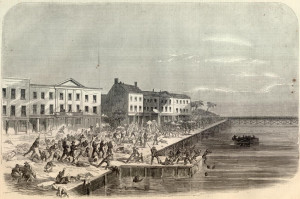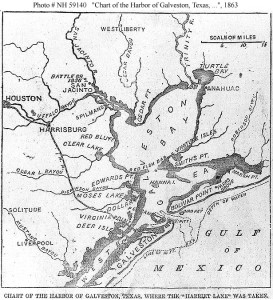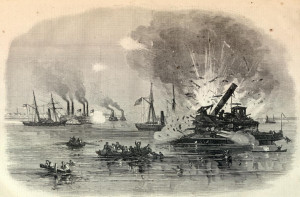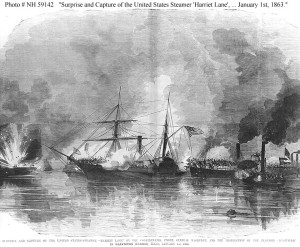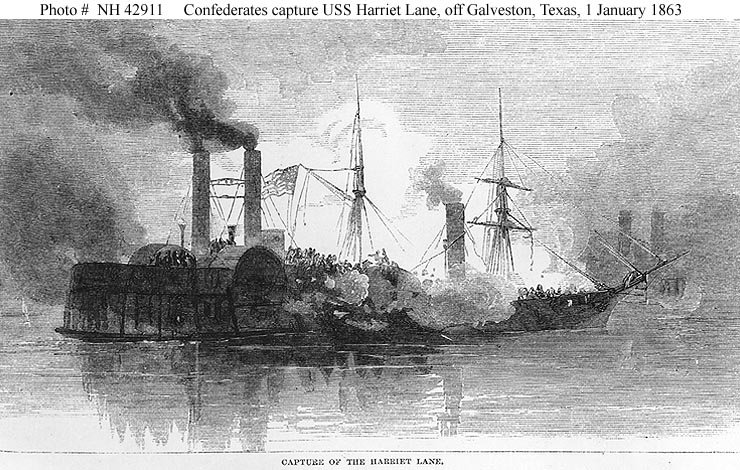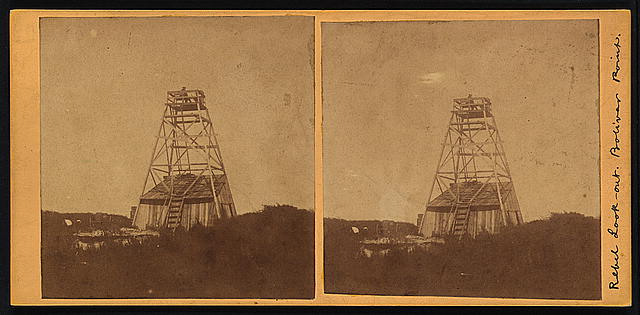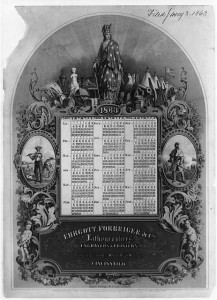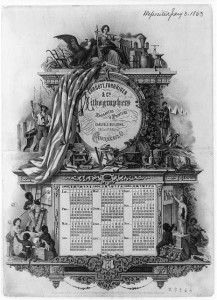Why it’s good to keep your pilot on board ship.
In the very early hours of 1863 a combined Confederate force under John Bankhead Magruder attacked the Union occupiers of Galveston, Texas. During the Battle of Galveston (or the Second Battle of Galveston) Southern infantry assaulted the small detachment from the 43rd Massachusetts in the city. Two Confederate cottonclads took on the Union ships in the harbor. One Northern ship was captured; another destroyed to prevent capture. John Arnett, a ship’s mate on the blown up Westfield, described his experience in a letter home to his father in Seneca Falls, New York.
From a Seneca County, New York newspaper in January, 1863:
Letter from John Arnett.
NEW ORLEANS, January 6, 1863.
Dear Father: – I arrived here three days ago in the transport M.L. Boardman, from Gavelston. You have probably heard ere this about our fight at Gavelston, and the blowing up of our vessel, (the Westfield) to prevent her falling into the hands of the enemy.
At about two o’clock, New Year’s morning, a large force of rebels came into the City by land, blockading the channel. – The Harriet Lane, Clifton, and Owasco were anchored close into the city. The Harriet Lane was boarded by two rebel steamers running alongside, when one of the most terrible hand-to-hand conflicts ensued, the Texans using their Bowies and the sailors the boarding pike. But unfortunately the odds were so heavy against us, in spite of our efforts, the Harriet Lane was captured, and the Secesh flag now waves over the hansomest vessel of the U.S.N. We beat to quarters immediately after the signal was made from the Harriet Lane that the enemy were approaching, and got under way to go to the head of the line, to give and receive the first fire; but our pilot being on board a transport which had arrived the day before, the vessel got ashore, and then we used every exertion to get her afloat without any avail, as we got on at high water and the tide leaving us high and dry.
The fighting was hard on both sides and loss heavy. The rebels got up in the windows of the houses overlooking the wharf, and kept up such a well directed and brisk fire on the Harriet Lane as to sweep her decks, besides the many field pieces they brought to bear on the vessels from the wharf. You cannot imagine how we felt. There we were ashore, and could not render any assistance to the other vessels, when we could see the flashes of the fire, and hear loud cannonading on both sides, and when daylight dawned to see two rebel steamers, one on each side of the Harriet lane, and then we knew she was captured. Com. Renshaw then gave orders for all hands to leave the ship, as he was going to destroy her. The enemy’s steamers were approaching, and we got into the boats and pulled for a Transport steamer. I was in the last boat that left the ship. The fire communicated with the magazine before we expected, and several of our crew were blown up with the vessel, including the Commodore, W.B. Renshaw, our 1st Lieuten[t], C.W. Zimmerman, and Chief Engineer W.R. Green.
It is hard to make an old sailor shed tears, but when we saw the explosion, knowing that the 1st Lieutenant was on board, whom every one of us loved so well, I really cannot find words to express my feelings at the time,only to say that it was the most sad scene that it has been my lot to witness in a long time. The old “tars” shed tears, and seemed as if they wanted to be blown up with him. For one I should have been willing to have gone up with her, sooner than to see her fall into the enemy’s hands.
The fight lasted about five hours and was a very hard one. Not over ten were left alive out of the Harriet Lane. Her Commander, Capt. Wainwright, Lieut. Lee [Lea?] and most of her officers were killed. I do not know how many were killed or wounded on the Owasco, but I think not many.
We had to leave the harbor then with the remaining vessels. There were 250 Union soldiers there. These 250 were all killed or taken prisoners.
I must close, as my time is up, and I have to report on some vessel, but I do not know which one as yet. My health is good. – I lost part of my clothes when the old Westfield went, but I am thankful that I did not lose my head.
Hastily, your affectionate son,
JOHN.
A poignant moment from the battle:
When a Confederate major [Albert Miller Lea] involved in the action arrived on the deck of the ship [the Harriet Lane], he found his son, a lieutenant in the Union navy, lying mortally wounded.[1]
According to the Wikipedia link on the battle, The Confederate Congress thanked “Prince John” Magruder and the entire Confederate force:
The bold, intrepid, and gallant conduct of Maj. Gen. J. Bankhead Magruder, Col. Thomas Green, Maj. Leon Smith and other officers, and of the Texan Rangers and soldiers engaged in the attack on, and victory achieved over, the land and naval forces of the enemy at Galveston, on the 1st of January, 1863, eminently entitle them to the thanks of Congress and the country… This brilliant achievement, resulting, under the providence of God, in the capture of the war steamer Harriet Lane and the defeat and ignominious flight of the hostile fleet from the harbor, the recapture of the city and the raising of the blockade of the port of Galveston, signally evinces that superior force may be overcome by skillful conception and daring courage.
As a result of the battle the South would control Galveston for the rest of the war, but actually the Union navy was able to maintain a blockade of the harbor.
The first and third images in this post are from the January 31, 1863 issue of Harper’s Weekly hosted at Son of the South, where you can also read an account of the battle.
_______________
1863 calendars
Here’s a couple calendars for 1863 (and then some). You can read the descriptions of the two calendars (left and right) at the Library of Congress. The one on the right anticipated Abraham Lincoln’s January 1, 1863 Emancipation Proclamation.
_______________
- [1]Catton, Bruce. The American Heritage New History of the Civil War. Ed. James McPherson. New York: Viking, 1996. Print. page 182↩

